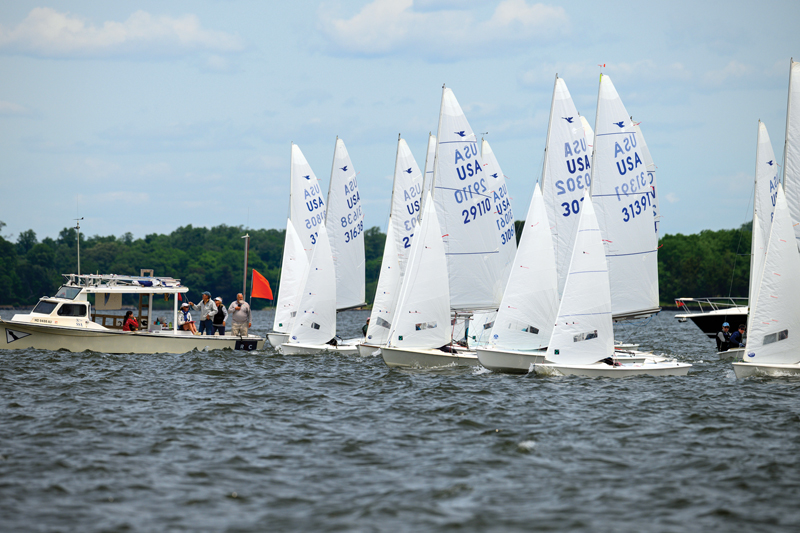Among the top factors to a good start: decisions about your final approach.
What makes a good start in a sailboat race? To vastly oversimplify, it’s crossing the line at full speed, heading in the direction you want to go, with clean air and little traffic, ideally at or near the favored end of the line if one exists, as the gun goes off.
Lots of elements go into getting a good start, and I’ll offer that the decision when and where to start your final approach to the line is one of the top factors. Getting this timing down is tough. Set up too early, and you’ll end up a sitting duck with no momentum, and other competitors can take advantage of you. Set up too late, and you risk not finding a spot.

What variables affect when to set up?
Length of the line relative to the size of the fleet. If the race committee has set a line that’s too short for the number of boats in your fleet, it’s like playing duck-duck-goose: You’ve got to get to your chair before the music stops. If you usually start lining up around 45 seconds to go, push it back another 20 seconds or so to reserve your spot on the line. You’ll need good boat handling to maintain your position, and a keen eye and quick reaction time to fend off any interlopers, but being able to stay in a spot where you’ll have clean air as the gun goes off is important.
Yes, it’s always nice to start near the favored end of the line (if there is one), but remember that the headstart you get from starting near the favored end is smaller on a short line than on a longer line. It’s often worthwhile to forgo some of the “favoredness” in lieu of being able to be on the line: I’d much rather be on the line not at the favored end than second row at the favored end in traffic.
The opposite is true, too: In multi-fleet regattas, where different-sized fleets use the same starting line sequentially, the race committee will often set the line long enough to support the largest fleet. If you’re in a smaller fleet, that means there will be more elbow room for your start.
Size of the fleet in general.
Often, we one-design dinghy sailors race in local fleets of 10 to 15 boats. It’s not too challenging to keep an eye on the trend of the fleet and to match when they get on final approach. But when fleets get bigger than 25 or so, it’s a lot more complex. Batches of boats may convince each other to head toward the line sooner or later than other groups. That makes it a lot easier to miss opportunities. To avoid losing out, it’s usually best to establish your turf a little earlier in the starting sequence than you might usually do.
The shiftiness factor. Is the wind locked in? You can lock in on the earlier side, too. But if the wind is oscillating, it may pay off to delay your final approach to the line. Keep an eye up the race course. Can you identify which side of the course the next breeze is coming from? As you transit from signal boat to pin and back again during your prestart, keep close tabs on the wind angle. How fast are the shifts coming—will you have one big shift each leg, or are puffs rolling in from either side every minute or so, shuffling the deck? That will help you decide whether to push closer to one end of the line or the other. In general, the shiftier it is, the later the entire fleet will set up, so there will likely be opportunities for a good slot... if you are proactive, that is.
Special note: Remember, unless it’s a long line or one end is very favored, making sure you are at the very end of the line may not be worth the tradeoffs you’ll encounter in more traffic. It’s important to find the right blend for your sailing style. If you struggle a bit getting off the line, whether it’s acceleration or driving skill to be able to hold a lane with a boat tight under you, consider not pushing it all the way into the traffic.
Share your plans!
No matter when you decide to make your final approach to the line, if you’re skippering a boat with crew, it’s a great idea to let them know you are “on final.” That way they can anticipate your moves better, whether it’s slowing down to maintain a good runway to the line, pointing out boats that might try to sneak in above or below you, or accelerating so you can cross the line at full speed!
By Kim Couranz
About the Author: Kim Couranz has earned several national and world titles in Laser Radials (ILCA 6), Snipes, and Lightnings. She has also raced J/22s, J/24s, and Ynglings on an international level.




